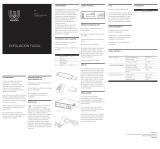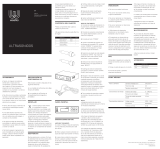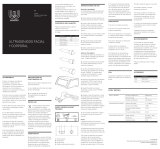TensCare ELISE 2 Manuel utilisateur
- Catégorie
- Mesure, test
- Taper
- Manuel utilisateur

0

1
QUICKSTART GUIDE
Connect the unit with the vaginal probe and insert
the probe
Conecte la sonda vaginal a la unidad y introduzca
la sonda
Connectez l’appareil à la sonde vaginale et insérez
la sonde
Verbinden Sie das Gerät mit der Vaginalsonde.
Führen Sie die Vaginalsonde ein
Press and hold the ON button to switch the device on
Presionar el botón de ON para encender el dispositivo
Appuyez sur le bouton ON pour allumer l’appareil
Halten Sie die ON-Taste gedrückt, um einzuschalten
Regulate the output intensity with + and -
Regule la intensidad con los botones + y -
Choisissez l’intensité avec + et -
Regulieren Sie die Intensität mit + und -
Press and hold the OFF button to switch the device off
Presionar el botón de OFF para apagar el dispositivo
Appuyez sur le bouton OFF pour éteindre l’appareil
Halten Sie die OFF-Taste gedrückt, um auszuschalten
Select the programme by pressing the button P
Seleccione el programa presionando el botón P
Choisissez le programme avec le bouton P
Wählen Sie ein Programm mit der P-Taste
1
2
ON
3
Button P
4
UP
DOWN
5
OFF
6
Clean the probe with an alcohol-free anti-bacterial wipe
or with warm soapy water
Limpie la sonda con una toallita antibacteriana sin
alcohol o con agua jabonosa tibia
Nettoyez la sonde avec une lingette antibactérienne
sans alcool ou de l'eau savonneuse tiède
Reinigen Sie die Sonde mit einem alkoholfreien
antibakteriellen Tuch oder lauwarmem Seifenwasser

2
Dear Customer,
Thank you for choosing Elise 2. TensCare stands for high-quality,
thoroughly tested products for the applications in the areas of gentle
electrotherapy, muscle toning, continence management and pain relief
during labour.
Please read these instructions for use carefully and keep them for later
use and observe the information they contain.
Best regards,
Your TensCare Team

3
Contents
1. INTRODUCTION ................................................................................................. 6
2. INTENDED USE .................................................................................................. 6
3. ELISE 2 FEATURES ........................................................................................... 6
4. PELVIC FLOOR EXERCISES ............................................................................. 7
4.1. PELVIC FLOOR MUSCLES .......................................................................... 7
4.2. PERFORMING PELVIC FLOOR EXERCISES ............................................. 8
5. TYPES OF INCONTINENCE ............................................................................... 9
6. HOW ‘EMS’ WORKS ........................................................................................... 9
7. CONTRAINDICATIONS, WARNINGS & CAUTIONS ........................................ 10
8. INFORMATION ABOUT THE PROGRAMME SETTINGS ................................ 14
9. PROGRAMMES ................................................................................................ 14
9.1 PROGRAMME SETTINGS ......................................................................... 14
9.2. PRESET PROGRAMMES .......................................................................... 14
10. CONTENT ...................................................................................................... 15
11. UNIT INFORMATION ..................................................................................... 16
11.1. CONTROLS & DISPLAY ......................................................................... 16
11.2. OPERATING INSTRUCTIONS ................................................................ 17
12. SETTING UP AND USING THE ELISE 2 ....................................................... 19
12.1. CHARGING THE BATTERY .................................................................... 19
12.2. CONNECTING LEAD WIRE .................................................................... 20
12.3. PREPARING FOR SESSION .................................................................. 20
12.4. TRAINING SESSION ............................................................................... 21
12.5. AFTER YOUR TRAINING SESSION ....................................................... 23
13. ANAL PROBE ................................................................................................ 23
13.1. CONDITIONS THAT MAY BE TREATED ................................................ 23
13.2. HOW TO INSERT THE ANAL PROBE .................................................... 24
14. CLEANING ..................................................................................................... 24
15. EMC ............................................................................................................... 25
16. DISPOSAL OF WASTE ELECTRICAL AND ELECTRONIC PRODUCTS
(WEEE) .................................................................................................................... 25
17. ACCESSORIES ............................................................................................. 25
18. WARRANTY ................................................................................................... 26
19. TROUBLESHOOTING ................................................................................... 27
20. GENERAL SPECIFICATION .......................................................................... 29

4
SYMBOLS USED
TYPE BF APPLIED PART: Equipment providing a degree of protection against
electric shock, with isolated applied part. Indicates that this device has conductive
contact with the end user.
This symbol on the unit means “Refer to instructions for use”.
Temperature Limitation: indicates the temperature limits to which the medical
device can be safely exposed.
Lot Number: indicates the manufacturer’s batch code so that the batch or lot can
be identified.
Humidity Limitation: indicates the humidity limits to which the medical device can
be safely exposed.
Serial Number: indicates the manufacturer’s serial number so that a specific
medical device can be identified.
Do not dispose in household waste.
Catalogue Number: indicates the manufacturer’s catalogue number so that the
device can be identified.
Atmospheric Pressure: indicates the atmospheric limits to which the medical
device can be safely exposed.
Manufacturer Symbol
Date of Manufacture: indicates the date which the medical device was
manufactured. This is included within the serial number found on the device
(usually on the back of the device), either as “E/Year/Number” (YY/123456) or
“E/Month/Year/Number” (MM/YY/123456).
CE Mark
Medical Device
This medical device is indicated for home use.
Importer Symbol

5
This medical device is not water resistant and should be protected from liquids.
The first number 2: Protected against access to hazardous parts with a finger,
and the jointed test finger of 12 mm ø, 80 mm length, shall have adequate
clearance from hazardous parts, and protected against solid foreign objects of
12.5 mm ø and greater.
The second number 2: Protected against vertically falling water drops when
enclosure is tilted up to 15˚. Vertically falling drops shall have no harmful effects
when the enclosure is tilted at any angle up to 15˚ on either side of the vertical.
Notes are used to provide clarification or recommendation.
A Warning is used when failure to follow the instructions may result in
serious injury or death.
A Caution is used when failure to follow the instructions may result in a
minor or moderate injury, or damage to the device or other property.
A Contraindication is used when a device should not be used because
the risk of use clearly outweighs any foreseeable benefits and may result
in serious injury or death.
IP22

6
1. INTRODUCTION
Device Description & Principles of
Design
Bladder leakage and incontinence are
common problems for both women and
men, affecting their long-term health.
Exercising the pelvic floor muscles is
recognised as the way of preventing
and treating symptoms of incontinence
and pelvic floor weakness.
The Elise 2 is a powered muscle
stimulator used for strengthening the
pelvic floor muscles.
It sends a gentle stimulation (similar to
your natural nerve impulses) direct to
your pelvic floor muscles through a
vaginal probe with stainless steel
electrodes. These signals make your
pelvic floor muscles contract. If you
have forgotten how to contract them,
are having trouble getting muscle
response, or simply want to bring back
the condition of your pelvic floor
muscles, the Elise 2 can work them for
you to build up their strength and help
you to develop your own muscle
control. It perfectly complements pelvic
floor exercises. The Elise 2 is very easy
to use, with four clearly labelled pre-set
training programmes and a simple push
button control.
The Elise 2 provides relief from
conditions such as:
• Urinary and faecal incontinence:
including stress, urge and mixed
types as well as post prostatectomy
urinary incontinence in men.
Additionally, it may help improve
sexual intimacy by toning the pelvic
floor muscles.
• Anal stimulation may also help men
who are otherwise unable to execute
Kegel exercises to strengthen their
pelvic floor. Pelvic floor muscle
training is recommended for
recovery from some causes of
Erectile Dysfunction. However it is
not intended to treat any medical
issues and your first step in deciding
appropriate therapy should be to
consult your professional medical
advisor.
2. INTENDED USE
Elise 2 is a medical device
designed to be used in the
home healthcare environment
to treat symptoms of urinary and/or
faecal incontinence and is suitable for
use by all who can control the device
and understand the instructions.
Do not use the device for any purpose
other than this intended use.
Warning: Not suitable for use
in children without medical
supervision.
3. ELISE 2 FEATURES
• Single Channel
Single channel unit provides relief from
symptoms of all types of incontinence
via a tampon-shaped probe.
• Comfortable Stimulation
Gentle, comfortable stimulation with
small steps of intensity, 0.5mA per step.
• 4 Pre-set Programmes

7
Clinically tested programmes for all
types of incontinence including
STRESS, URGE, MIXED and a TONE
aftercare programme.
• Treatment Timer
Unit defaults to 20 minutes treatment to
ensure the pelvic floor muscle is not
over-worked. The user can manually
reset this to 10, 20, 30, 45, 60 or 90
minutes.
For the Urge programme the unit
defaults to a C (Continuous) treatment
session. This timer is ONLY available
for the Urge programme.
• Open Circuit Detection
Automatically resets the strength to
zero and flashes ‘LEADS’ if the
connection comes loose.
• Large Backlit Screen
Clearly shows the operation of the unit
and the programme and intensity
currently being used.
• Memory
Features 3 functions: programme
retention (automatically starts in the last
programme used), duration of use and
average strength used.
4. PELVIC FLOOR
EXERCISES
4.1. PELVIC FLOOR
MUSCLES
The “FLOOR” of your pelvis is made up
of layers of muscles that support the
bowel, bladder, urethra and uterus.
These muscles are like a hammock, or
the bottom and sides of a bowl, in
shape. They run from the pubic bone in
the front to the end of the spinal column
(or tail bone) in the back.
The pelvic floor muscles:
• Assist in supporting the abdominal
and pelvic organs.
• Work with the abdominal and back
muscles to stabilise and support the
spine.
• In women, also
o provide support for the baby
during pregnancy and
o assist in the birthing process
Pelvic floor muscles are also important
for sexual function.
• In women, voluntary contractions
(squeezing) of the pelvic floor
contribute to sexual sensation and
arousal.
However pelvic floor muscles may
become weak. If your pelvic floor
muscles become stretched or
weakened, your pelvic organs may no
longer be fully supported, and you may
lose control of your bladder or bowel
movements.
For some women, the pelvic floor
muscles can also become too tight.
This condition is less common, but it
can lead to pelvic pain and make it
difficult for you to empty your bladder or
bowel completely.

8
Common signs that can indicate a
pelvic floor problem include:
• Accidentally leaking urine when you
exercise, laugh, cough or sneeze
• Needing to get to the toilet in a hurry
or not making it there in time
• Constantly needing to go to the toilet
• Finding it difficult to empty the
bladder or bowel
• Accidentally losing control of the
bladder or bowel
• Accidentally passing wind
• Pain in your pelvic area
• Painful sex, or
• A prolapse
In women, this may be felt as a bulge in
the vagina or a feeling of heaviness,
discomfort, pulling, dragging or
dropping. This occurs when one or
more of the pelvic organs (bladder,
bowel or uterus) become displaced and
sag down into the vagina. It is very
common in the United Kingdom and
occurs in about 40% of women.
Symptoms tend to become
exacerbated towards the end of each
day and if left untreated, they will
generally worsen over time.
In men, this may be felt as a bulge in
the rectum or a feeling of needing to
use the bowel but not actually needing
to go.
Like other muscles in your body, the
pelvic floor can be strengthened with
regular exercise. Building pelvic floor
strength enables the muscles to better
support your pelvic organs, improves
your bladder and bowel control and can
stop accidental urine, faeces or wind
leakage.
It can also reduce your risk of prolapse,
improve your recovery from childbirth
and gynaecological surgery, and
increase your sexual pleasure. A
continence therapist can help you learn
how to exercise your pelvic floor.
Doing just a few pelvic floor exercises
every day will help to treat bladder
weakness or prolapse symptoms, and
will help to prevent problems later on.
4.2. PERFORMING PELVIC
FLOOR EXERCISES
It is recommended to make Pelvic Floor
Exercises (sometimes called Kegel
Exercises) part of your daily life.
1) Kegel exercises can be done at any
time and are very discreet so you can
do them almost anywhere; lying in
bed, sitting at the computer or
waiting for a bus. It is a good idea to
try and develop a routine which you
can repeat each day.
2) First, it is important to find your pelvic
floor muscles and feel them working.
So here are a couple of techniques
which might help:
Try inserting one or two clean fingers
into your vagina and then squeezing
the surrounding muscles, lifting up
and towards your belly button – a
squeezing and lifting sensation.
Another way is to try and stop the
flow of urine during urination. If you
are successful, then you know you
are exercising the correct muscles.
Note: These techniques are
just to help you confirm that you
are using the correct muscles.
It is important to have an empty bladder
before starting the exercises.
3) Try to remember the lifting and
squeezing sensation and when you
are ready try to recreate it just using

9
the muscles you identified earlier;
don't tense the muscles in your legs,
stomach or buttocks and remember
to breathe normally.
4) Aim to hold each squeeze or
'contraction' for three to five
seconds, then release and relax.
You should feel a ‘letting go’ of the
muscles. Rest for five seconds and
then repeat.
5) Try and do about ten squeezes in
this way.
6) Repeat the whole process three or
four times a day.
7) Over a period of time try to increase
the muscle contractions up to about
ten seconds, but remember to rest in
between each squeeze for longer
periods.
Note: It is important to aim for
quality contractions, not
quantity, so a few good hard
squeezes are better than a series of
weak ones.
Do not worry if you find holding for 3
seconds difficult at first. Just squeeze
for as long as you feel comfortable to do
so. The more exercise you do, the
stronger the muscles will become and
the longer you will be able to squeeze.
8) Using your Elise 2 pelvic floor
stimulator in conjunction with Kegel
exercises will give you a better
understanding of how they work and
how to get the greatest benefit from
them.
5. TYPES OF
INCONTINENCE
There are three types of incontinence:
Stress, Urge, and Mixed.
Stress Incontinence
If you leak urine when you cough,
sneeze, laugh, strain or make sudden
movements, this is called Stress
Incontinence.
It is particularly common in women who
have had a natural childbirth and occurs
when the bladder neck and the other
mechanisms that act to hold urine in the
bladder are not working properly. The
most common cause is a weak pelvic
floor.
Urge Incontinence
Describes an overactive bladder. A
person may experience a strong and
sudden urge to go to the toilet but are
not always able to hold on, or must go
so frequently that it becomes
inconvenient.
Mixed Incontinence
Is a combination of both Stress and
Urge Incontinence.
6. HOW ‘EMS’ WORKS
E.M.S. stands for Electrical Muscle
Stimulation and has successfully been
used in medical rehabilitation and
training in competitive sports. EMS

10
produces intensive and effective
muscular contraction.
In rehabilitation, EMS is a well-
established method for treatment of a
broad field of musculoskeletal
diagnoses as well as pelvic floor
weakness. Electrical stimulation of an
intact peripheral nervous system may
create motor responses in patients with
impaired or lost ability for voluntary
muscle activity.
EMS is a complement to other physical
therapy and should always be
combined with active training such as
Kegel exercises (see section 4.2.).
Advantages of EMS
Use of EMS may lead to faster progress
in the patient’s treatment programme.
The method is simple and appropriate
for treatment in the clinical setting as
well as for self-treatment at home.
How EMS Works
Electrical Muscle Stimulators can play a
vital role in educating women and men
about their pelvic floor and the
sensation they should feel when doing
pelvic floor exercises. Electrical Pelvic
Floor Exercisers (PFE) offer a non-
invasive method of producing
contraction of muscles via a gentle
stimulation to the pelvic floor through a
discreet probe or electrode pads when
they are placed close to the nerve that
controls the pelvic floor muscles. This
current then passes into the nerve
fibres controlling that part of the muscle
stimulating it to contract. So, electrical
stimulation (EMS) artificially activates a
muscle for you enabling you to develop
your own muscle control. These
contractions exercise the muscles and,
as with any kind of exercise if
performed regularly, build strength and
tone.
In urge incontinence, pelvic floor
exercisers work in a slightly different
way. The electrical stimulation is
designed to soothe your bladder
muscles rather than exercise your
pelvic floor. Elise 2 uses a gentler, low
frequency setting which promotes
release of endorphins and reduces
involuntary contractions of the bladder
(detrusor) muscle.
Different frequencies have different
effects; low frequencies (1-10 Hz)
coupled with long impulse times, for
example, have a purifying and relaxing
effect through individual contractions,
whereby the circulation in the treated
muscle is simultaneously improved and
removal of metabolic end products is
supported (lymphatic drainage). The
oxygen supply to the muscle is
improved.
In contrast, by means of a rapid
succession of contractions (fibrillation),
medium frequencies (20-50 Hz) can put
a high level of strain on the muscle, thus
promoting the muscular structure.
7. CONTRAINDICATIONS,
WARNINGS &
CAUTIONS
CONTRAINDICATIONS:
Do NOT use if you are or may be
pregnant. It is not known whether TENS
may affect foetal development.

11
Do NOT use with optional electrode
pads if you have a pacemaker (or if you
have a heart rhythm problem) or with
any electronic medical devices. Using
this unit with electronic medical devices
may cause erroneous operation of the
device. Stimulation in the direct vicinity
of an implanted device may affect some
models.
Do NOT use in the first 6 weeks
following a pelvic surgery or vaginal
childbirth. Stimulation may disrupt the
healing process.
Do NOT use if you have symptoms of
active urinary tract infection, vaginal
infections, or localized lesions.
Introducing the probe may irritate
sensitive tissue.
Do NOT use if you have poor sensation
in the pelvic region. You may not be
able to control the intensity of
stimulation safely.
WARNINGS:
Do NOT use if you are unable to
properly insert the vaginal or anal
probe. If you have a severe prolapse, or
if any discomfort occurs when inserting
the probe, consult your healthcare
professional before use.
Do NOT use when driving, operating
machinery, or similar actions needing
muscular control. Loose electrode
pads, damaged leads, or sudden
changes in contact may cause brief
involuntary muscle movements.
Do NOT use to mask or relieve
undiagnosed pain. This may delay
diagnosis of a progressive condition.
Do NOT use if you have, in the area
being treated: active or suspected
cancer or undiagnosed pain with a
history of cancer. Stimulation directly
through a confirmed or suspected
malignancy should be avoided as it may
stimulate growth and promote spread of
cancer cells.
Do NOT use optional electrodes on the
front of the neck. Stimulation on the
front of the neck can affect your heart
rate or cause contraction of the throat.
Do NOT use optional electrodes across
the chest. Very strong stimulation
across the chest may cause an extra
heartbeat and/or rhythm disturbances
to your heart, which could be lethal.
Do NOT use while simultaneously
connected to high frequency surgical
equipment as it may result in burns at
the site of stimulator electrodes and
possible damage to the stimulator.
Do NOT use Elise 2 in close proximity
(e.g. 1 m) to a shortwave or microwave
as this may produce instability in the
stimulator output.
Do NOT use electrodes near the thorax
as this may increase the risk of cardiac
fibrillation.
Do NOT use any charger other than the
one supplied. Use of other chargers
could be hazardous.
Do NOT use the device whilst charging.
CAUTIONS:
Caution should be used if you have a
bleeding disorder as stimulation may
increase blood flow to the stimulated
region.
Caution should be used if you have
suspected or diagnosed epilepsy as
electrical stimulation may affect seizure
threshold.

12
Caution should be observed when
using the device at the same time as
being connected to monitoring
equipment with body worn electrode
pads. It may interfere with the signals
being monitored.
Caution Do not permit use by persons
unable to understand the instructions or
persons with cognitive disabilities, i.e.;
Alzheimer’s disease or dementia.
Caution: Insertion of the vaginal or anal
electrode makes it unsuitable for use in
children without clinical supervision.
Caution: Keep away from children
under 5 years of age. Long lead wires -
risk of strangulation in infants.
Caution should be observed when
using the Elise 2 at high strength
settings. Prolonged use at high settings
may cause muscle injury or tissue
inflammation.
Caution Not intended for use in an
oxygen rich environment.
Caution Not intended for use in
conjunction with flammable
anaesthetics or flammable agents.
Caution The patient is an intended
operator.
Caution Do not service and maintain
the device while in use.
Caution Maintenance and all repairs
should only be carried out by an
authorized agency. The manufacturer
will not be held responsible for the
results of maintenance or repairs by
unauthorized persons.
If necessary, we will provide circuit
diagrams, component part lists or other
information that will assist authorized
service personnel to repair the device.
Caution The operator should not touch
the patient at the same time when
touching the battery output.
Caution Keep away from pets and
pests.
Caution: Interconnect this device with
other equipment may damage this
device or unintended output may be
delivered to end user.
Note: No serious or long term
adverse effects have been
reported. Mild adverse
reactions are very rarely reported, but
these have included muscular pain and
cramps, vaginal tenderness, irritation
and bleeding, mild or short term urge or
faecal incontinence, and tingling
sensation in legs. If you experience any
of these, stop use. When symptoms
have gone, try resuming at a lower
intensity setting.
TO KEEP YOUR DEVICE IN GOOD
WORKING ORDER, OBSERVE THE
FOLLOWING ADDITIONAL
CAUTIONS:
Caution: Do not immerse your device
in water or place it close to excessive
heat such as a fireplace or radiant
heater or sources of high humidity such
as a nebulizer or kettle as this may
cause it to cease to operate correctly.
Caution: Keep the device away from
sunlight, as long-term exposure to
sunlight may affect the rubber causing
it to become less elastic and crack.
Caution: Keep the device away from
lint and dust, as long-term exposure to
lint or dust may affect the sockets or
cause the battery connector to develop
a bad contact.

13
Caution: Temperature & Relative
Humidity of storage: -10°C–+60°C,
15%-75% R.H. Temperature & Relative
Humidity of transportation: -10°C–
+60°C, 15%-75% R.H.
Caution: There are no user serviceable
parts. Do not attempt to open or modify
the unit. This may affect the safe
operation of the unit and will invalidate
the warranty.
PROBE CAUTIONS:
Caution: The Elise 2 vaginal probe is
intended for single patient use only. Do
not share your Elise 2 probe with
anyone else. Improper treatment or
cross-infection may occur.
Caution: It is important that the vaginal
probe is cleaned after each use.
Ineffective cleaning may lead to
irritation or infection.
Caution: Never insert or remove
vaginal probe unless the control unit is
powered OFF as insertion or removal
when stimulation is active may cause
discomfort or tissue irritation.
Caution: If tissue irritation occurs,
discontinue treatment immediately. Ask
your healthcare professional for advice
before continuing further treatment to
prevent injury.
Caution: Do not use a silicone-based
lubricant on the metal plates of the
probe as it may decrease the
effectiveness of Elise 2’s muscle
stimulation.
Caution: Do not use this device with
vaginal probe or anal probe other than
those recommended by the
manufacturer in section 17. Electrodes
with smaller surface area may cause
tissue irritation.
DO NOT PLACE OPTIONAL
ELECTRODE PADS:
• On skin, which does not have normal
sensation. If the skin is numb too
great a strength may be used, which
could result in skin inflammation.
• On broken skin. The electrode pads
could encourage infection.
ELECTRODE PADS CAUTION:
Caution: Do not ignore any allergic
reaction to the electrode pads: If a skin
irritation develops, stop use
immediately, as this type of electrodes
may not be suitable for you. Alternative
electrode pads specially made for
sensitive skin are available (see E-696-
SS).
Caution: Do not use this device with
leads or electrode pads other than
those recommended by the
manufacturer. Performance may vary
from specification. Electrodes with
smaller surface area may cause tissue
irritation.
Caution: Do not use high intensity
settings if electrodes are smaller than
50x50mm.
The electrode pads supplied are
reusable but for single patient use. The
adhesive is a peelable hydrogel (water
based).
Note: You may safely use the
stimulator during menstruation,
although it may be a little less
comfortable.
Note: EU Regulations require
that any incident involving this

14
medical device that led or might have
led to the death of a patient, serious
deterioration of state of health of a
patient, or a serious public health
threat, should be reported immediately
to the manufacturer, and to the
Competent Authority in the Member
State in which the user resides.
8. INFORMATION ABOUT
THE PROGRAMME
SETTINGS
Each programme has its own
combination of Frequency and Pulse
Width settings which allow for different
sensations through the probe or
optional electrode pads and help
treating the different types of
incontinence.
• Frequency (measured in Hz -
pulses per second)
Low frequencies (1-10 Hz) have a
purifying and relaxing effect through
individual contractions.
Medium frequencies (20-50 Hz) can put
a high level of strain on the muscle, thus
promoting the muscular structure.
• Pulse Width (measured in μs -
millionths of a second)
The Elise 2 unit has pulse widths of 200
to 300 μs. Generally speaking, the
higher the pulse width, the more
"aggressive" the stimulation feels, if the
pulse width is set high enough, it will
usually elicit a muscle contraction,
which is required for an effective toning
of the pelvic floor muscles.
9. PROGRAMMES
9.1 PROGRAMME SETTINGS
9.2. PRESET PROGRAMMES
The Elise 2 has four pre-set
programmes. One for each type of
incontinence (stress, urge and mixed),
and one for toning the pelvic floor
muscles (TONE).
STRESS INCONTINENCE:
Shown on the screen as: STRES
The STRES incontinence programme
strengthens the muscles of the pelvic
floor using gentle stimulation. Once
these muscles are stronger, they are
better able to resist urinary leakage
caused by external pressure being
applied to the bladder such as with a
cough, sneeze or physical exertion.
The stimulation causes the muscles to
contract and work. This builds their
strength. Like other fitness training,
successful treatment requires
stimulation once a day for one to three
Prog
STRES
URGE
MIXED
TONE
Freq.
(Hz)
50
10
10/
50
35
Pulse
width
(μs)
300
200
200/
300
250
Ramp Up
& Down
(s)
1
Constant
Con/
1
2
Plateau
(s)
5
Con/
5
3
Rest (s)
10
Con/
10
6
Default
duration
(min)
20
Conti-
nuous
10/
10
20

15
months. Improvement starts becoming
apparent after about four weeks.
The sensation is like a strong drawing
in of the muscles of the vagina, pulling
up the pelvic floor. Your natural reaction
will be to pull your muscles in and up,
and this exercises and strengthens
them.
URGE INCONTINENCE:
Shown on the screen as: URGE
The URGE programme works in a
different way to the STRES
programme. The gentle continuous
stimulation soothes the bladder
(detrusor) muscle, reducing its
involuntary contractions. This prevents
the unwanted and unexpected
emptying of the bladder.
Successful treatment requires
stimulation once a day and
improvements can sometimes be seen
in as little as two weeks.
The sensation is a softer, vibrating,
stimulation. Nevertheless, when the
programme finishes, and your pelvic
floor relaxes, it will become apparent
how much your pelvic floor has been
exercised.
MIXED INCONTINENCE:
Shown on the screen as: MIXED
This programme is perfect if you are
suffering from both Stress and Urge
incontinence. It is a combination of the
STRES and URGE programmes.
The first 10 minutes uses the URGE
programme to reduce sensitivity, then
in the second 10 minutes, the STRES
programme exercises the pelvic floor
muscles. You may need to increase the
strength to feel the muscle contraction
when the STRES programme starts.
The Mixed programme can ONLY be
set to a 20-minute time session.
TONE:
Shown on the screen as: TONE
Once the pelvic floor muscles have
been strengthened with Elise 2,
continue to exercise them.
Regular use of this programme, about
twice a week, will ensure that your
muscles remain fit and toned.
The TONE programme may also be
used as an alternative treatment for
stress incontinence.
The sensation when using the TONE
programme is a mixture of a strong
drawing in of the muscles and then
releasing.
A strong and fit pelvic floor may
increase sexual health and enjoyment.
10. CONTENT
The pack contains:
• 1 x Elise 2 continence stimulator unit
• 1 x Lead wire (L-ELGR)
• 1 x Short probe lead (L-VPCE)
• 1 x Liberty probe (X-VP)
• 1 x Li-ion battery BL-4B (B-BL4B)
• 1 x Battery Cover (X-EL2C)
• 1 x Charger (UK/EU)
(X-EL2CH1000MA)
• 1 x Storage pouch
• 1 x Manual instruction
m
i
n

16
11. UNIT INFORMATION
11.1. CONTROLS & DISPLAY
Programme
selected
Programme
selector
Time selector
ON/OFF button
Programme
duration (min)
Strength
selected (mA)
Strength up
Strength down

17
11.2. OPERATING
INSTRUCTIONS
ON/OFF
To turn the unit on, press the
ON/OFF button and hold for 3 to
5 seconds until the display shows.
To turn the unit off, press the ON/OFF
button and hold for 3 to 5 seconds until
the display stops.
When switched on the unit will
automatically start in the programme
which was being used when it was last
switched off.
During start up to stop the increase in
strength at any time, press any key
once.
The unit will turn off automatically:
• When the Timer reaches zero,
• If it is left at zero strength for more
than 5 minutes.
Note: Always check unit is
OFF before applying or
removing probe or pads.
STRENGTH CONTROLS
The buttons marked + and - are
the strength controls.
To increase strength, press and
hold down the button + until
required strength is achieved.
To decrease the strength, press and
release the button -.
To increase strength in steps of 0.5 mA,
press and release the button +.
The unit will remain in the WORK part
of the cycle for 5 seconds while
intensity is being adjusted.
The strength levels are shown on the
LCD.
The strength control buttons will not
operate until the unit is properly
connected to you (probe inserted
correctly). Elise 2 detects a
disconnection and automatically
returns the strength to zero.
The unit has levels of strength from 0 to
99.0 mA in steps of 00.5 mA. If you hold
down the button + for 3 to 5 seconds,
the strength will start scrolling.
You may feel nothing over the first few
presses. Continue pressing until the
sensation is strong but comfortable.
Further increases during use may be
necessary if your body becomes used
to the sensation.
PROGRAMME CONTROL
The button marked P is the
programme control. The Elise 2
has four pre-set programmes. At first
use, the unit automatically goes to
programme STRES. Next time it is
switched on, it will default to the
programme used last.
Each time you press and release the P
button, the programme changes and is
shown on the LCD.
Each time you change the programme,
the strength level reverts back to zero.
This is a safety feature to alleviate any
sudden feeling of a surge, as each
programme gives a different sensation.
P
+
-

18
TREATMENT TIMER
The button marked T can be
used to set the session duration.
When you switch the unit on, it is
automatically set at 20 minutes.
To set a different time, set the strength
to zero and press T. The min display
will flash.
You can set session times of 10, 20, 30,
45, 60 or 90 minutes with the T button.
The C (Continuous) session timer is
ONLY available for the Urge
programme.
The LCD shows the session duration in
minutes. The unit automatically counts
down the minutes set and switches off
when it reaches 0.
If you hold down this key for 3 to 5
seconds, you can pause the timer,
allowing you to interrupt the treatment
session, and resume it later. Return to
main screen by pressing any other key.
LOW BATTERY
When the battery is running low, the
word BATT will show on the screen.
Although the display fades as the
batteries run down, the strength of the
output does not change until the
warning is shown.
LEADS ALARM
The Elise 2 monitors the connection
and the contact between you and the
probe, or the pads. This is to prevent
sudden changes if a broken connection
is re-made. If either of these goes
outside of a standard range while the
strength is above 20.0 mA, the unit will
flash LEADS, bleep three times, and
return the strength to 00.0 mA.
Check the lead and if necessary,
lubricate the probe with a water based
lubricant such as TensCare Go Gel
(see K-GO). Please see section 19 for
more troubleshooting tips.
MEMORY
The Elise 2 has a Memory with three
functions:
1) Programme Retention. When you
switch the unit on, it will automatically
start in the programme which was being
used when it was switched off.
2) Usage. To activate hold down the T
and + buttons together for 3 to 5
seconds. The display will show the total
duration of use in 10 minute intervals
(where 1=10 minutes, 2=20 minutes
etc.) and the average strength used.
Press the same buttons again to return
to normal controls.
3) Memory Reset. To reset memory to
zero, hold down the T and OFF buttons
together for 3 to 5 seconds.
T
Time used
in 10 minute
intervals
Average
strength

19
12. SETTING UP AND
USING THE ELISE 2
12.1. CHARGING THE
BATTERY
The Elise 2 is powered by a type BL4B
rechargeable Li-ion battery. A power
adaptor with an interchangeable plug is
also included in the kit. The battery
should need charging about once a
month. The battery should last at least
15 hours at 50 mA, 300 μs, 50 Hz.
Unused batteries have a nominal shelf
life of 1 year, but will usually last linger
than this. To fully charge the battery it
will take about 2 hours.
When the battery is running low, the
word BATT will show on the screen.
Although the display fades as the
batteries run down, the strength of the
output does not change until the
warning is shown.
Note: The device comes with
the battery already inside.
Avoid removing the battery
cover on the back unless absolutely
necessary. A replacement battery
cover is required if the original cover is
removed.
Warning: Use only the
charger supplied. Use of other
chargers could be hazardous
and will negate the warranty.
To charge the battery:
Connect the charger to the unit and
plug it into the mains socket.
The word “BATT” will appear on the
charging display – that means the
battery is being charged.
When the battery is charged, the word
will change from “BATT” to “FULL”.
Note: The device should be
charged at least once every 3
months to ensure the battery
life is maintained.
Note: The device cannot be
used while being charged.
Note: Charging voltage: DC
5V, charging current: 60mA.
Note: Use adapters of the
following specifications.
• Output: DC 5 V; 1A
• Rated input voltage shall not
exceed 250 V
• Classification of protection
against electric shock: Class II
• IP classification: at least IP21
• The adapter need to comply
with IEC 60601-1 or IEC
60950-1
Battery Warnings
This product is equipped with a Lithium-
ion battery. Failure to follow these
instructions could cause the lithium-ion
battery to leak acid, become hot,
explode or ignite and cause injury and
/or damage:
Do NOT pierce, open, disassemble, or
use in a humid and/or corrosive
environment.
Do NOT expose to temperatures over
60°C(140F).
Do NOT put, store or
leave near sources of heat, in direct
La page est en cours de chargement...
La page est en cours de chargement...
La page est en cours de chargement...
La page est en cours de chargement...
La page est en cours de chargement...
La page est en cours de chargement...
La page est en cours de chargement...
La page est en cours de chargement...
La page est en cours de chargement...
La page est en cours de chargement...
La page est en cours de chargement...
La page est en cours de chargement...
La page est en cours de chargement...
La page est en cours de chargement...
La page est en cours de chargement...
La page est en cours de chargement...
La page est en cours de chargement...
La page est en cours de chargement...
La page est en cours de chargement...
La page est en cours de chargement...
La page est en cours de chargement...
La page est en cours de chargement...
La page est en cours de chargement...
La page est en cours de chargement...
La page est en cours de chargement...
La page est en cours de chargement...
La page est en cours de chargement...
La page est en cours de chargement...
La page est en cours de chargement...
La page est en cours de chargement...
La page est en cours de chargement...
La page est en cours de chargement...
La page est en cours de chargement...
La page est en cours de chargement...
La page est en cours de chargement...
La page est en cours de chargement...
La page est en cours de chargement...
La page est en cours de chargement...
La page est en cours de chargement...
La page est en cours de chargement...
La page est en cours de chargement...
La page est en cours de chargement...
La page est en cours de chargement...
La page est en cours de chargement...
La page est en cours de chargement...
La page est en cours de chargement...
La page est en cours de chargement...
La page est en cours de chargement...
La page est en cours de chargement...
La page est en cours de chargement...
La page est en cours de chargement...
La page est en cours de chargement...
La page est en cours de chargement...
La page est en cours de chargement...
La page est en cours de chargement...
La page est en cours de chargement...
La page est en cours de chargement...
La page est en cours de chargement...
La page est en cours de chargement...
La page est en cours de chargement...
La page est en cours de chargement...
La page est en cours de chargement...
La page est en cours de chargement...
La page est en cours de chargement...
La page est en cours de chargement...
La page est en cours de chargement...
La page est en cours de chargement...
La page est en cours de chargement...
La page est en cours de chargement...
La page est en cours de chargement...
La page est en cours de chargement...
La page est en cours de chargement...
La page est en cours de chargement...
La page est en cours de chargement...
La page est en cours de chargement...
La page est en cours de chargement...
La page est en cours de chargement...
La page est en cours de chargement...
La page est en cours de chargement...
La page est en cours de chargement...
La page est en cours de chargement...
La page est en cours de chargement...
La page est en cours de chargement...
La page est en cours de chargement...
La page est en cours de chargement...
La page est en cours de chargement...
La page est en cours de chargement...
La page est en cours de chargement...
La page est en cours de chargement...
La page est en cours de chargement...
La page est en cours de chargement...
La page est en cours de chargement...
La page est en cours de chargement...
La page est en cours de chargement...
La page est en cours de chargement...
La page est en cours de chargement...
La page est en cours de chargement...
La page est en cours de chargement...
La page est en cours de chargement...
La page est en cours de chargement...
La page est en cours de chargement...
La page est en cours de chargement...
La page est en cours de chargement...
La page est en cours de chargement...
La page est en cours de chargement...
La page est en cours de chargement...
La page est en cours de chargement...
La page est en cours de chargement...
La page est en cours de chargement...
La page est en cours de chargement...
La page est en cours de chargement...
La page est en cours de chargement...
-
 1
1
-
 2
2
-
 3
3
-
 4
4
-
 5
5
-
 6
6
-
 7
7
-
 8
8
-
 9
9
-
 10
10
-
 11
11
-
 12
12
-
 13
13
-
 14
14
-
 15
15
-
 16
16
-
 17
17
-
 18
18
-
 19
19
-
 20
20
-
 21
21
-
 22
22
-
 23
23
-
 24
24
-
 25
25
-
 26
26
-
 27
27
-
 28
28
-
 29
29
-
 30
30
-
 31
31
-
 32
32
-
 33
33
-
 34
34
-
 35
35
-
 36
36
-
 37
37
-
 38
38
-
 39
39
-
 40
40
-
 41
41
-
 42
42
-
 43
43
-
 44
44
-
 45
45
-
 46
46
-
 47
47
-
 48
48
-
 49
49
-
 50
50
-
 51
51
-
 52
52
-
 53
53
-
 54
54
-
 55
55
-
 56
56
-
 57
57
-
 58
58
-
 59
59
-
 60
60
-
 61
61
-
 62
62
-
 63
63
-
 64
64
-
 65
65
-
 66
66
-
 67
67
-
 68
68
-
 69
69
-
 70
70
-
 71
71
-
 72
72
-
 73
73
-
 74
74
-
 75
75
-
 76
76
-
 77
77
-
 78
78
-
 79
79
-
 80
80
-
 81
81
-
 82
82
-
 83
83
-
 84
84
-
 85
85
-
 86
86
-
 87
87
-
 88
88
-
 89
89
-
 90
90
-
 91
91
-
 92
92
-
 93
93
-
 94
94
-
 95
95
-
 96
96
-
 97
97
-
 98
98
-
 99
99
-
 100
100
-
 101
101
-
 102
102
-
 103
103
-
 104
104
-
 105
105
-
 106
106
-
 107
107
-
 108
108
-
 109
109
-
 110
110
-
 111
111
-
 112
112
-
 113
113
-
 114
114
-
 115
115
-
 116
116
-
 117
117
-
 118
118
-
 119
119
-
 120
120
-
 121
121
-
 122
122
-
 123
123
-
 124
124
-
 125
125
-
 126
126
-
 127
127
-
 128
128
-
 129
129
-
 130
130
-
 131
131
-
 132
132
TensCare ELISE 2 Manuel utilisateur
- Catégorie
- Mesure, test
- Taper
- Manuel utilisateur
dans d''autres langues
- English: TensCare ELISE 2 User manual
- español: TensCare ELISE 2 Manual de usuario
- Deutsch: TensCare ELISE 2 Benutzerhandbuch
Documents connexes
-
 TensCare ALIVIA Manuel utilisateur
TensCare ALIVIA Manuel utilisateur
-
 TensCare SURE+ Manuel utilisateur
TensCare SURE+ Manuel utilisateur
-
 TensCare UNICARE Manuel utilisateur
TensCare UNICARE Manuel utilisateur
-
 TensCare ITOUCH SURE Manuel utilisateur
TensCare ITOUCH SURE Manuel utilisateur
-
 TensCare KEGEL TONER Manuel utilisateur
TensCare KEGEL TONER Manuel utilisateur
-
TensCare X-PR13 Mode d'emploi
-
TensCare I-CM50100PM Manuel utilisateur
-
 TensCare Perfect EMS Manuel utilisateur
TensCare Perfect EMS Manuel utilisateur
-
 TensCare Sports TENS 2 Manuel utilisateur
TensCare Sports TENS 2 Manuel utilisateur
Autres documents
-
 Restore The Floor Innovo Manuel utilisateur
Restore The Floor Innovo Manuel utilisateur
-
Enraf-Nonius VAGINAL EMG SONDE Manuel utilisateur
-
Enraf-Nonius NN ELEKTR. T.B.V. 3444.652 Manuel utilisateur
-
Enraf-Nonius ANALE EMG SONDE Manuel utilisateur
-
 Silkn TIGHTRA PLEIEUTSTYR FOR INTIMOMRÅDET Le manuel du propriétaire
Silkn TIGHTRA PLEIEUTSTYR FOR INTIMOMRÅDET Le manuel du propriétaire
-
 Weelko B-Equipment F311A Le manuel du propriétaire
Weelko B-Equipment F311A Le manuel du propriétaire
-
PawHut D31-012BU Assembly Instructions
-
Medline MDS6301600 Series Ring Pessary Manuel utilisateur
-
 Weelko B-Equipment F312A Le manuel du propriétaire
Weelko B-Equipment F312A Le manuel du propriétaire
-
 Weelko U-tech F801C Le manuel du propriétaire
Weelko U-tech F801C Le manuel du propriétaire















































































































































